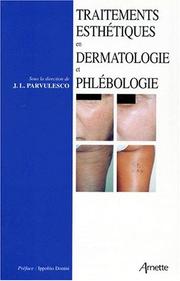| Listing 1 - 6 of 6 |
Sort by
|
Periodical
ISSN: 00318280 Year: 1948 Publisher: Paris Librairie des facultes
Abstract | Keywords | Export | Availability | Bookmark
 Loading...
Loading...Choose an application
- Reference Manager
- EndNote
- RefWorks (Direct export to RefWorks)
Veins. --- #ANTILTPNE9606 --- Vein --- Periodicals --- Veins
Book
ISBN: 0815140118 Year: 1995 Publisher: St. Louis ; Naples ; London Mosby
Abstract | Keywords | Export | Availability | Bookmark
 Loading...
Loading...Choose an application
- Reference Manager
- EndNote
- RefWorks (Direct export to RefWorks)
Multi
ISBN: 909001909X
Abstract | Keywords | Export | Availability | Bookmark
 Loading...
Loading...Choose an application
- Reference Manager
- EndNote
- RefWorks (Direct export to RefWorks)
Fysiologie --- Physiologie --- Ischemia --- Coronary Vessels. --- Heart --- Cardiomegaly --- Hypertension --- Coronary Veins --- Coronary Arteries --- Sinus Node Artery --- Arteries, Coronary --- Arteries, Sinus Node --- Artery, Coronary --- Artery, Sinus Node --- Coronary Artery --- Coronary Vein --- Coronary Vessel --- Sinus Node Arteries --- Vein, Coronary --- Veins, Coronary --- Vessel, Coronary --- Vessels, Coronary --- Myocardium --- physiopathology. --- blood supply --- Theses --- Coronary Vessels --- physiopathology
Book
ISSN: 01847155 01847155 ISBN: 9782251005362 9782251005447 9782251005553 9782251005560 9782251005843 9782251006093 9782251006284 2251006281 2251005366 2251005447 2251005560 2251005552 2251006095 Year: 2019 Volume: 545 Publisher: Paris: Les Belles Lettres,
Abstract | Keywords | Export | Availability | Bookmark
 Loading...
Loading...Choose an application
- Reference Manager
- EndNote
- RefWorks (Direct export to RefWorks)
Si vous buvez aujourd'hui une tisane à la fin du repas, vous ignorez sans doute que c'est en raison de la fortune d'un texte oublié : le commentaire de Galien au Régime des maladies aiguës d’Hippocrate. Le premier livre de ce commentaire porte en effet sur la prescription de la « ptisane », une décoction d’orge que les médecins antiques, médiévaux et modernes ont utilisée pour nourrir et soigner les patients atteints de maladies infectieuses (ou maladies aiguës). Après avoir été traduit en arabe, puis en latin, ce commentaire fut l’un des textes médicaux les plus étudiés en Occident entre le XIIIe et le XVIe siècle.A. Pietrobelli propose une nouvelle édition critique du livre I, mais aussi sa première traduction en langue moderne, accompagnée d’un commentaire. À travers ce texte, on perçoit les méthodes exégétiques de Galien et son érudition sur Hippocrate. Cette édition permet aussi de comprendre un chapitre important de l’histoire de la médecine, notamment sur les théories de la digestion et des fièvres. Mais ce livre a surtout un grand intérêt pour l’histoire de la philosophie : Galien défend l’idée que c’est dans le Régime des maladies aiguës qu’Hippocrate a inventé, avant Platon et Aristote, la méthode logique des philosophes.
Medicine, Greek and Roman --- Philosophy, Ancient --- Ancient philosophy --- Greek philosophy --- Philosophy, Greek --- Philosophy, Roman --- Roman philosophy --- Greek medicine --- Medicine, Roman --- Medicine, Unani --- Roman medicine --- Tibb (Medicine) --- Unani medicine --- Unani-Tibb (Medicine) --- Medicine, Ancient --- Classical Greek literature --- Classical Greek philosophy and medicine - Critical edition. --- Arteries --- Medicine, Greek and Roman. --- Neuroanatomy --- Philosophy, Ancient. --- Veins --- Anatomy --- Thériaque. --- Médecine grecque et romaine. --- Transmission des textes. --- Galien, Claude --- Hippocrate --- Critique et interprétation. --- Appréciation. --- Human medicine --- History of human medicine --- Human anatomy --- Galen --- Blood-vessels --- Nerves --- Nervous system --- Neurobiology --- Galen. --- Hippocrates. --- Neuroanatomy - Early works to 1800 --- Veins - Anatomy - Early works to 1800 --- Arteries - Anatomy - Early works to 1800

ISBN: 2718408774 Year: 1998 Publisher: Vélizy-Villacoublay Arnette
Abstract | Keywords | Export | Availability | Bookmark
 Loading...
Loading...Choose an application
- Reference Manager
- EndNote
- RefWorks (Direct export to RefWorks)
Aesthetic surgery --- Chirurgie [Plastische ] --- Chirurgie correctrice --- Chirurgie cosmétique --- Chirurgie esthétique --- Chirurgie plastique --- Chirurgie reconstructive --- Chirurgie réparatrice --- Cosmetic surgery --- Dermatologie --- Dermatology --- Interventions plastiques --- Opérations plastiques --- Plastic surgery --- Plastie --- Plastische chirurgie --- Reconstructive surgery --- Surgery [Aesthetic ] --- Surgery [Cosmetic ] --- Surgery [Plastic ] --- Surgery [Reconstructive ] --- Dermatoses --- Varices --- Esthétique. --- Thérapeutique. --- Esthétique. --- Thérapeutique. --- Veins --- Diseases --- Treatment --- Skin --- Surgery
Book
ISBN: 9789004337428 9789004337435 9004337431 9004337423 Year: 2017 Volume: 48 Publisher: Leiden Boston
Abstract | Keywords | Export | Availability | Bookmark
 Loading...
Loading...Choose an application
- Reference Manager
- EndNote
- RefWorks (Direct export to RefWorks)
The distinction that Praxagoras of Cos (4th-3rd c. BC) made between arteries and veins and his views on pulsation and pneuma are two significant turning points in the history of ideas and medicine. In this book Orly Lewis presents the fragmentary evidence for this topic and offers a fresh analysis of Praxagoras’ views on the soul and the functions of the heart and pneuma. In so doing, she highlights the empirical basis of Praxagoras’ views and his engagement with earlier medical debates and with Aristotle’s physiology. The study consists of an edition and translation of the relevant fragments (some absent from the standard 1958 edition) followed by a commentary and a synthetic analysis of Praxagoras’ views and their place in the history of medicine and ideas.
Medicine, Greek and Roman. --- Cardiovascular system --- Arteries --- Veins --- Pulse --- Soul --- Praxagoras, --- Criticism and interpretation. --- Circulatory system --- Vascular system --- Blood --- Greek medicine --- Medicine, Roman --- Medicine, Unani --- Roman medicine --- Tibb (Medicine) --- Unani medicine --- Unani-Tibb (Medicine) --- Medicine, Ancient --- Heart --- Heart beat --- Physical diagnosis --- Vital signs --- Blood-vessels --- Circulation --- Diseases --- Diagnosis
| Listing 1 - 6 of 6 |
Sort by
|

 Search
Search Feedback
Feedback About UniCat
About UniCat  Help
Help News
News